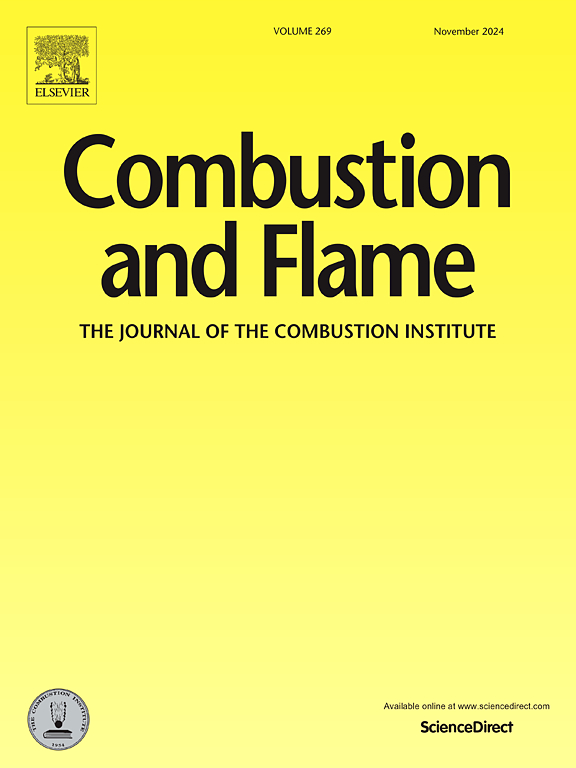Unraveling the low-temperature chemistry of nitrogenous compounds by informatively kinetic modeling of N,N-dimethylformamide
IF 6.2
2区 工程技术
Q2 ENERGY & FUELS
引用次数: 0
Abstract
N,N-Dimethylformamide (DMF) is a volatile organic pollutant prevalent in many modern industrial processes and an intermediate formed in nitrogenous compound low-temperature oxidation. The low-temperature oxidation of DMF was performed between 450 and 900 K under fuel-lean conditions (Φ = 0.5) in a jet-stirred reactor coupled with synchrotron vacuum ultraviolet photoionization molecular beam mass spectrometry. Weak negative temperature coefficient (NTC) behavior was observed within 520 - 650 K. A comprehensive kinetic model was developed based on the previous pyrolysis model. Key reaction parameters, including hydrogen atom abstraction, first O2 addition to fuel radicals, and intermediate radical decomposition pathways, were determined through ab initio - transition state theory - RRKM/ME calculation. The model successfully predicts DMF consumption and major product formation, though discrepancies persist for certain intermediates due to remaining uncertainties in nitrogen chemistry. Kinetic analysis reveals that at NTC temperatures, DMF oxidation is predominantly controlled by carbonyl-site oxygen addition followed by rapid QOOH radical decomposition, generating CH3NCH2, CO2, and OH through Waddington-type reactions and inhibiting second O2 addition. In contrast, methyl-site O2 addition exhibits higher reaction barriers for QOOH decomposition, enabling second oxygen addition and subsequent low-temperature chain-branching reaction pathways critical for NTC behavior. Based on recent advances in nitrogen compound oxidation kinetics, the generalized behavior of different types of nitrogen-containing compounds was further discussed. Compounds with primary and secondary nitrogen atoms rarely exhibit NTC behavior due to preferential HO2 elimination from α-site ROO radicals via adjacent N![]() H sites, effectively suppressing low-temperature reactivity. Conversely, tertiary nitrogen compounds lacking N
H sites, effectively suppressing low-temperature reactivity. Conversely, tertiary nitrogen compounds lacking N![]() H bonds can undergo efficient auto-oxidation through rapid intramolecular hydrogen migration. It generates highly oxygenated intermediates along with OH radicals and, therefore, is very likely to exhibit NTC behavior, though its magnitude depends on the competition between fuel-specific rates of oxygen addition and QOOH decomposition.
H bonds can undergo efficient auto-oxidation through rapid intramolecular hydrogen migration. It generates highly oxygenated intermediates along with OH radicals and, therefore, is very likely to exhibit NTC behavior, though its magnitude depends on the competition between fuel-specific rates of oxygen addition and QOOH decomposition.
Novelty and significance statement
The negative temperature coefficient (NTC) behavior of nitrogenous compounds was first experimentally reported during the low-temperature oxidation of N,N-dimethylformamide. Leveraging advanced diagnostic techniques and comprehensive high-level ab initio calculations, we developed an informative kinetic model that successfully reproduces the observed oxidation behavior. Through detailed model analysis and integration with recent advances in nitrogenous compound low-temperature chemistry, we have formulated general principles governing NTC behavior in nitrogen-containing species. These findings significantly enhance our fundamental understanding of nitrogen chemical kinetics relevant to both low-temperature auto-ignition processes and pollutant abatement technologies.
通过N,N-二甲基甲酰胺的信息动力学模型揭示含氮化合物的低温化学
N,N-二甲基甲酰胺(DMF)是一种普遍存在于许多现代工业过程中的挥发性有机污染物,是氮化合物低温氧化形成的中间体。采用同步加速器真空紫外光电离分子束质谱法,在450 ~ 900 K的低温氧化条件下(Φ = 0.5)对DMF进行了低温氧化。在520 ~ 650 K范围内观察到弱的负温度系数(NTC)行为。在前人热解模型的基础上,建立了综合动力学模型。通过从头算-过渡态理论- RRKM/ME计算,确定了氢原子抽离、第一个O2加入燃料自由基、中间自由基分解途径等关键反应参数。该模型成功地预测了DMF的消耗和主要产物的形成,尽管由于氮化学的不确定性,某些中间体仍然存在差异。动力学分析表明,在NTC温度下,DMF氧化主要受羰基氧加成和QOOH自由基快速分解控制,通过waddington型反应生成CH3NCH2、CO2和OH,抑制O2的二次加成。相比之下,甲基氧加成对QOOH的分解表现出更高的反应障碍,从而实现了二次氧加成和随后的低温链支反应途径,这对NTC的行为至关重要。根据氮化合物氧化动力学的最新进展,进一步讨论了不同类型含氮化合物的一般行为。含有叔氮原子和仲氮原子的化合物很少表现出NTC行为,这是因为α-位点的ROO自由基通过邻近的NH位点优先消除了HO2,有效地抑制了低温反应活性。相反,缺乏NH键的叔氮化合物可以通过快速的分子内氢迁移进行有效的自氧化。它与OH自由基一起产生高氧中间体,因此很可能表现出NTC行为,尽管其大小取决于燃料特定的氧添加率和QOOH分解率之间的竞争。新颖性和意义性声明N,N-二甲基甲酰胺低温氧化过程中氮化合物的负温度系数(NTC)行为首次被实验报道。利用先进的诊断技术和全面的高级从头计算,我们开发了一个信息丰富的动力学模型,成功地再现了观察到的氧化行为。通过详细的模型分析,结合氮化合物低温化学的最新进展,我们制定了含氮物种中NTC行为的一般原则。这些发现极大地增强了我们对低温自燃过程和污染物减排技术相关的氮化学动力学的基本理解。
本文章由计算机程序翻译,如有差异,请以英文原文为准。
求助全文
约1分钟内获得全文
求助全文
来源期刊

Combustion and Flame
工程技术-工程:化工
CiteScore
9.50
自引率
20.50%
发文量
631
审稿时长
3.8 months
期刊介绍:
The mission of the journal is to publish high quality work from experimental, theoretical, and computational investigations on the fundamentals of combustion phenomena and closely allied matters. While submissions in all pertinent areas are welcomed, past and recent focus of the journal has been on:
Development and validation of reaction kinetics, reduction of reaction mechanisms and modeling of combustion systems, including:
Conventional, alternative and surrogate fuels;
Pollutants;
Particulate and aerosol formation and abatement;
Heterogeneous processes.
Experimental, theoretical, and computational studies of laminar and turbulent combustion phenomena, including:
Premixed and non-premixed flames;
Ignition and extinction phenomena;
Flame propagation;
Flame structure;
Instabilities and swirl;
Flame spread;
Multi-phase reactants.
Advances in diagnostic and computational methods in combustion, including:
Measurement and simulation of scalar and vector properties;
Novel techniques;
State-of-the art applications.
Fundamental investigations of combustion technologies and systems, including:
Internal combustion engines;
Gas turbines;
Small- and large-scale stationary combustion and power generation;
Catalytic combustion;
Combustion synthesis;
Combustion under extreme conditions;
New concepts.
 求助内容:
求助内容: 应助结果提醒方式:
应助结果提醒方式:


